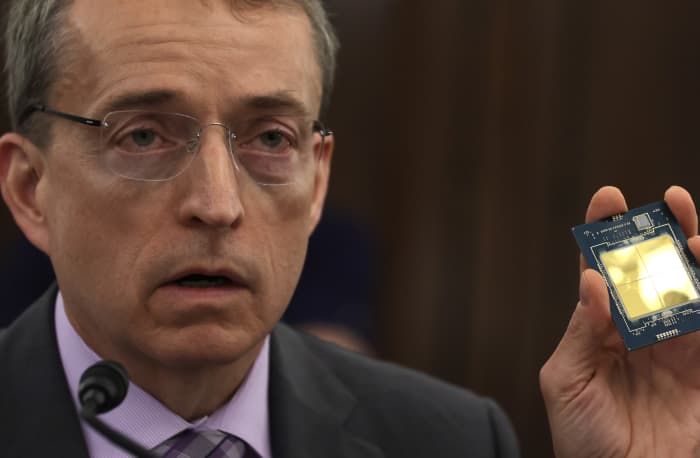What say you TSMC? Intel expansion plan is Too Big to Fail and you're not part of it.
Earnings Outlook
As Intel hits a year of building, Wall Street is worried the chip boom may be slipping away
Published: April 26, 2022 at 12:36 p.m. ET
By
Intel earnings preview: CEO Pat Gelsinger is using proceeds from semiconductor squeeze to build more capacity, and analysts are concerned about what that means when the squeeze ends
Intel CEO Pat Gelsinger holds up a semiconductor as he testifies during March 23 Senate committee.
ALEX WONG/GETTY IMAGES
Intel Corp. executives have been focusing on increasing capacity long-term as semiconductors have been in short supply, but Wall Street is worried about what happens when there is no longer a short supply.
Intel
is scheduled to report first-quarter earnings on Thursday after the close of markets, following a quarter where the chip maker’s buildout plans included acquisitions. In mid-February, Intel announced a
to buy Israel-based chip maker Tower Semiconductor Ltd. for its fab capacity, on top of plans to spend more than $20 billion to build a
and $20 billion for
. Intel also acquired Israel-based cloud-optimization software company
for an undisclosed amount, with one report citing an estimate of
.
All that comes a year after Chief Executive Pat Gelsinger
for an aggressive build-out since taking the helm of Intel. At Intel’s investor meeting in earlier this year, Gelsinger laid out his vision with an outlook that was
and
. Intel also forecast that its battered margins should recover beginning around 2025 as the company continues to turn itself around.
Wall Street has never really been on board with Intel’s plans to spend a lot of money to build out capacity, and analysts are now concerned about the eventual end of the COVID-triggered chip shortage, which has rocketed chip makers to record profits. As
, continuing outperformance for chips such as Intel’s central processing units, or CPUs, could also be at an end.
Read:
Intel’s stock “now appears to have both tactical as well as structural concerns,” wrote Bernstein analyst Stacy Rasgon, who rates Intel’s stock as an “underperform” with a $40 price target.
“In the near term, ‘peak PC’ worries are now being incrementally demonstrated in consumer notebook builds, with CPU inventory correction now clearly apparent,” Rasgon said. “And structurally the company’s recent analyst day was not incredibly well taken with investors now having to face the reality of declining margins, nonexistent free cash flow, and forward revenue targets that appear challenging (if not outlandish) with the recent server roadmap pushout further muddying the share picture in their most important market.”
What to look for
Earnings: Of the 36 analysts surveyed by FactSet, Intel on average is expected to post adjusted earnings of 78 cents a share, down from the 82 cents a share the company reported a year ago. Intel forecast 80 cents a share. Estimize, a software platform that uses crowdsourcing from hedge-fund executives, brokerages, buy-side analysts and others, calls for adjusted earnings of 85 cents a share.
Revenue: Wall Street expects revenue of $18.33 billion from Intel, according to 31 analysts polled by FactSet. That would be down from the $18.57 billion reported in the year-ago quarter, making for a seventh quarter of revenue declines from the year-ago quarter. Intel predicted revenue of $18.3 billion. Estimize expects revenue of $18.51 billion.
Analysts surveyed by FactSet expect revenue from client computing to come in at $9.42 billion; data center revenue of $6.78 billion; nonvolatile memory solutions revenue of $898.5 million; “Internet of Things,” or IoT, revenue of $1.01 billion; and Mobileye revenue of $415.8 million.
Investing Insights with Global Context
Understand how today’s global business practices, market dynamics, economic policies and more impact you with real-time news and analysis from MarketWatch.
Read:
Stock movement: Speaking of a possible seventh straight quarter of revenue declines, even if Intel beats expectations — as it generally does — shares have fallen following the company’s over the past seven quarterly earnings reports.
Over the March-ending quarter, Intel stock declined 3.8%, while the Dow Jones Industrial Average
— which counts Intel as a component — fell 4.6%, the S&P 500 index
dropped 5%, the tech-heavy Nasdaq Composite Index
shed 9.1%, and the PHLX Semiconductor Index
dropped 13.1%.
What analysts are saying
Susquehanna Financial analyst Christopher Rolland, who has a neutral rating and a $52 price target, echoed those worries about inventory, which, he said, could pass into the second half of the year.
Read:
Rolland, however, said that Intel could have a “saving grace” in that his checks indicate that the company gained modest market share in desktops and laptops in the first quarter. Intel’s biggest rival when it comes to a market-share battle is Advanced Micro Devices Inc.
“In short, we expect a generally in-line quarter and guide, but note building intermediate-term risks as we move through 2022 given a weakening PC demand backdrop and potential margin headwinds,” Rolland said.
Citi Research analyst Christopher Danley, who has a neutral rating and a $58 price target, expects Intel to guide to a flat quarter-over-quarter $18.3 billion because of weaker notebook sales.
“Our neutral rating on Intel is driven by our expectation of cuts to consensus estimates driven by share loss to AMD and microprocessor inventory correction in 2H22 as PC end market demand reverts to the mean,” Danley said.
Read:
Of the 40 analysts who cover Intel, nine have a buy rating on the stock, 22 have a hold rating, and nine have a sell rating, along with an average target price of $52.15, according to FactSet data
As
Intel hits a year of building, Wall Street is worried the chip boom may be slipping away. Published:
April 26,
2022 at 12:36 p.m. ET.

